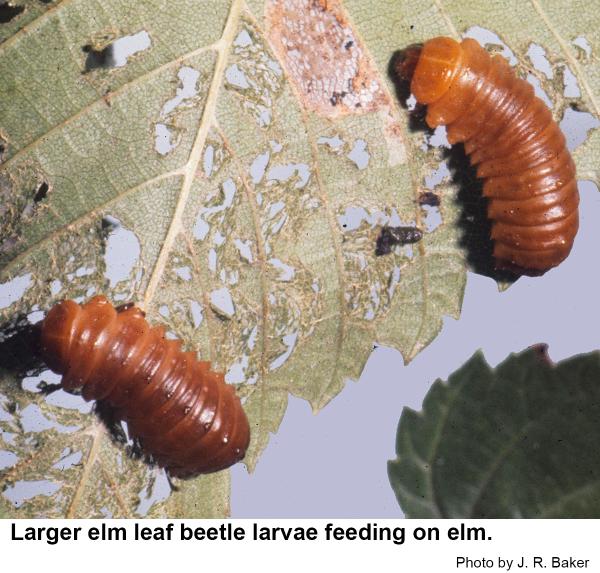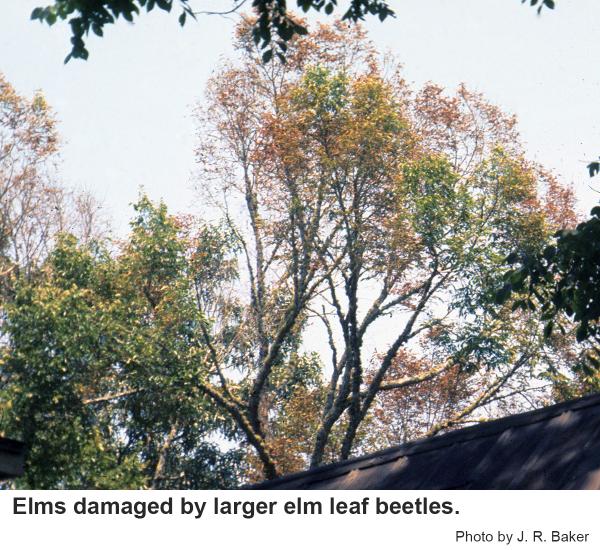General Information
The larger elm leaf beetle, Monocesta coryli, is 3/8 to 5/8 inches long. It is orange with four dark to metallic blue spots. On some specimens, the spots form two broad bands across the wings. Larvae are up to ¾ inch long and are also orange, conspicuous, and easily recognized.
Biology
The larger elm leaf beetle often suddenly appears in great numbers, does tremendous defoliation for a year or two and then disappears for years. Sometimes groups of larvae can be seen on the soil surface beneath a tree. The beetles overwinter as grubs in the soil. In spring they pupate, and new adults emerge from the soil and begin laying 24 to 58 eggs in yellow, crusty masses on the undersides of leaves. Eggs hatch in about two weeks. New larvae are about 1/8 inch long and greenish-yellow. They feed in groups for three or four days before dispersing. Mature larvae crawl down the tree and wander for a few days before digging into the soil to overwinter. Grubs pupate the next spring, and new adults begin emerging in May. Adults and larvae excrete an orange fluid when disturbed.
Host Plants
Elm is the major host for the larger elm leaf beetle, but it also feeds on dogwood, hazelnut, pecan, river birch, plum, and hawthorn. It is more damaging for an elm to be defoliated in the spring than later in the summer or fall. Adult larger elm leaf beetles chew holes in the leaves and lay their eggs on the leaves. The larvae skeletonize leaves as they feed.
Residential Recommendations
The tachinid fly, Icelia triquetra, and other parasites usually keep populations of larger elm leaf beetles below noticeable levels From time to time, these beetles "escape" their parasites, predators, and diseases and become noticeable defoliators for a year or two. They then seem to die away perhaps as parasites etc. catch up with the population. Larger elm leaf beetles are not reported to be resistant to insecticides, so it can be controlled with most insecticides available in garden centers that are labeled for residential landscape use. If severe defoliation occurs early in the growing season, and if the tree is small enough to treat, and if the tree is important in the landscape, it may be worthwhile applying an insecticide. Most of the pyrethroid insecticides for sale in garden centers labeled for residential use should give more than adequate control. When used as directed, pyrethroids are very toxic to insects but are not particularly hazardous to humans and pets (other than fish-avoid using pyrethroids around pools, ponds, and streams).
References
- Common name: larger elm leaf beetle, scientific name: Monocesta coryli (Say) (Insecta: Coleoptera: Chrysomelidae). Thomas, M. C. 2000 (rev. 2007). Featured Creatures. Entomology & Nematology,| FDACS, DPI, EDIS.
- Larger elm leaf beetle, Monocesta coryli (Say) (Coleoptera: Chrysomelidae). Anonymous. No date. Forest Pest Insects in North America: a Photographic Guide.
- Larger Elm Leaf Beetle (Monocesta coryli). Anonymous. 2018. Insect Identification for the casual observer.
- Extension Plant Pathology Publications and Factsheets
- Horticultural Science Publications
- North Carolina Agricultural Chemicals Manual
For assistance with a specific problem, contact your local Cooperative Extension center.
Publication date: July 28, 2015
Reviewed/Revised: Sept. 25, 2019
N.C. Cooperative Extension prohibits discrimination and harassment regardless of age, color, disability, family and marital status, gender identity, national origin, political beliefs, race, religion, sex (including pregnancy), sexual orientation and veteran status.



